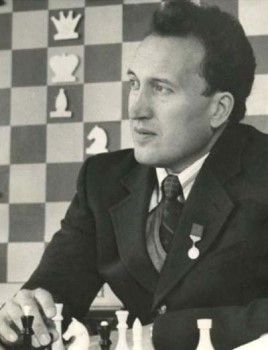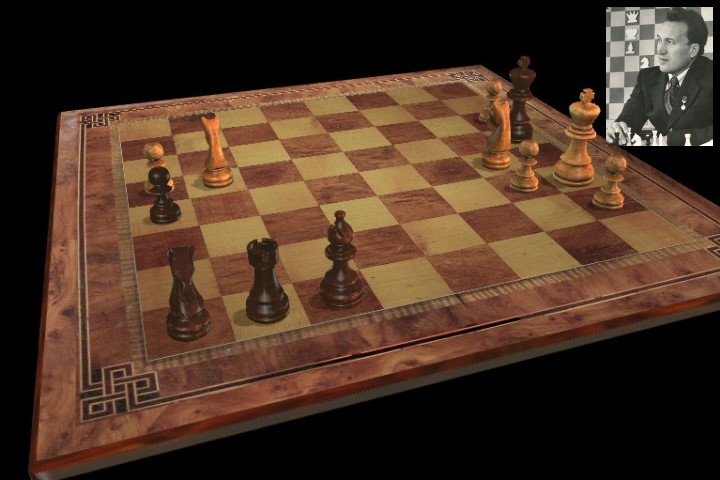Study of the Month: April 2020
While it is not celebrated or observed by all chess composers, the 4th of January is the International Day of Chess Composition. Sure, if you get some major institution to accept your proposal or just boldly name something yourself, the Year of X, Day of X, or even Month of X can be proclaimed. Or you proclaim the menu of the day, the song of the year...or the study of the month. Oh, wait.
 The proposal to have the 4th of January named as International Day for Chess Composition was made by Valentin Rudenko, who would have become 82 years old a couple of months ago (b. February 19th, 1938), but sadly passed away on April 2nd, 2016. The now World Federation for Chess Composition (then the FIDE subcommittee PCCC) accepted Rudenko’s proposal in 2007 at the congress in Rhodes, Greece.
The proposal to have the 4th of January named as International Day for Chess Composition was made by Valentin Rudenko, who would have become 82 years old a couple of months ago (b. February 19th, 1938), but sadly passed away on April 2nd, 2016. The now World Federation for Chess Composition (then the FIDE subcommittee PCCC) accepted Rudenko’s proposal in 2007 at the congress in Rhodes, Greece.
As the WFCC website states, the Bohemian magazine “Svetozor” had one of Antonín König’s articles on January 4th, 1869 as one of the first ones to name chess composition as an independent art form. König (1836-1911) was one of the founders of the Bohemian School, which is connected to pure checkmates. More information on this Chess Composition School can be found in our earlier articles of the “Chech Czech Chess”. Essentially, it requires at least three variations with checkmates that involve all white material and all black squares being only impossible to be moved to for a single reason — for example it is protected by a white piece, blocked by a black piece or is not threatened but would be if the king moved to it (for example, if a line piece delivers checkmate from the other side).
In the village Shorshely, a problem by Valentin Rudenko is on exhibit in a museum. How did this happen? Well, the museum is, as Alexey Oganesjan informed me in 2016 (naming also the correct city, previously misreported as Cheboksary), the Space Museum of Andrian Nikolaev, the third cosmonaut. Nikolaev was on a small space mission called “Soyuz 9”. Valentin Rudenko, who worked in cosmonautics, somehow got his chess problem from Suomen Shakki 1957 (1st prize) to Nikolaev. Were they personally known to each other? What more information can be provided by readers?
In any case, Nikolaev took a piece of paper from that publication with him into space. It was not the first time that chess entered space, but probably was the first time a chess composition did. Over a decade ago an astronaut even challenged the general public to a game.
Certainly, Valentin Fyodorovich Rudenko is not the first name you think about when you discuss endgame studies, but indeed he created over two dozen — most of them with Tigran Gorgiev, the “Maestro of Practical Studies” (book title by Sergei N. Thachenko). Chess composition often has to do with curiosities as well, but often those manifest in the stories around it. One such curiosity is Rudenko’s occupation. The American language has the phrase “shoot the moon”, used mostly figuratively. Rudenko’s life was dedicated to two meanings of the phrase. The figurative one in his chess compositions, where he attained great heights, and the literal one in his workplace.
Click or tap an entry in the list to switch positions
You probably know that you can move pieces on our replay boards to analyse and even start an engine to help you. You can maximize the replayer, auto-play, flip the board and even change the piece style in the bar below the board.
At the bottom of the notation window on the right there are buttons for editing (delete, promote, cut lines, unannotate, undo, redo) save, play out the position against Fritz and even embed the ChessBase game viewer on your website or blog. Hovering the mouse over any button will show you its function.
Perfect endgame analysis and a huge increase in engine performance: Get it with the new Endgame Turbo 5! This brings the full 6-piece Syzygy endgame tablebases on a pendrive. Just plug it in a USB socket and you are set!

World Federation for Chess Composition (www.wfcc.ch)
Links


















 The proposal to have the 4th of January named as International Day for Chess Composition was made by Valentin Rudenko, who would have become 82 years old a couple of months ago (b. February 19th, 1938), but sadly passed away on April 2nd, 2016. The now World Federation for Chess Composition (then the FIDE subcommittee PCCC) accepted Rudenko’s proposal in 2007 at the congress in Rhodes, Greece.
The proposal to have the 4th of January named as International Day for Chess Composition was made by Valentin Rudenko, who would have become 82 years old a couple of months ago (b. February 19th, 1938), but sadly passed away on April 2nd, 2016. The now World Federation for Chess Composition (then the FIDE subcommittee PCCC) accepted Rudenko’s proposal in 2007 at the congress in Rhodes, Greece.





